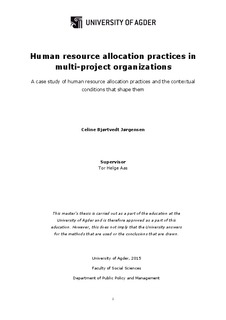| dc.description.abstract | It has been claimed that “project-based business activities are part of all private firms and public organizations” (Artto & Kujala, 2008, p. 469), and that two thirds of the work carried out in companies is organized in projects (Karlesen, 2013). Along with its popularity, project-orientation has gained massive traction in the research community. In spite of the attention given to project-oriented organizations - where tools and methods for control, management and resource allocation has been developed in plenty - less attention has been given to how these tools and methods work in practice. Particularly little research has been done on multi-project environments. We know relatively little about how human resources are actually allocated to- from- and between projects in multi-project organization, and even less research has been done on how the context impact these allocation practices.
This study aims at filling the research gap on human resource allocation practices, and discovers how practices are influenced by contextual conditions. In this sense, the study contributes to establish patterns of behaviour for human resource allocation that could be used to form new theory on multi-project management. The study also offer useful insight into how organizational context shape behaviour in the project and organization in its entirety.
The study builds on the knowledge gaps in current management theories and studies of resource allocation in multi-project organizations. Data has been collected from two case-organizations, where respondents have identified different practices used to allocate human resources and visualized the interplay between their choice of practices and contextual variables. The finds reveal contextual conditions to affect human resource allocation practices – some of which correlates with prior studies on similar topics, and some of which are entirely new contributions to the understanding of the relationship between allocation practice(s) and context. Project size and duration, resource availability, and degree of formalization are found to influence the allocation of human resources, supporting suggestions put forth by current literature. Formalization is presented as a mediator variable. This is particularly interesting, because it can help explain causal connections that are found empirically- and statistically, but not entirely understood. The study also find market conditions and customer’s expectations to have a significant effect on the allocation practices in the two cases-organizations, conditions that no prior studies have empirically revealed to influence the allocation practice(s). As a final outcome of the study, a model for human resource allocation practices is presented, along with a model portraying the effect of contextual conditions on allocation practices. | nb_NO |
